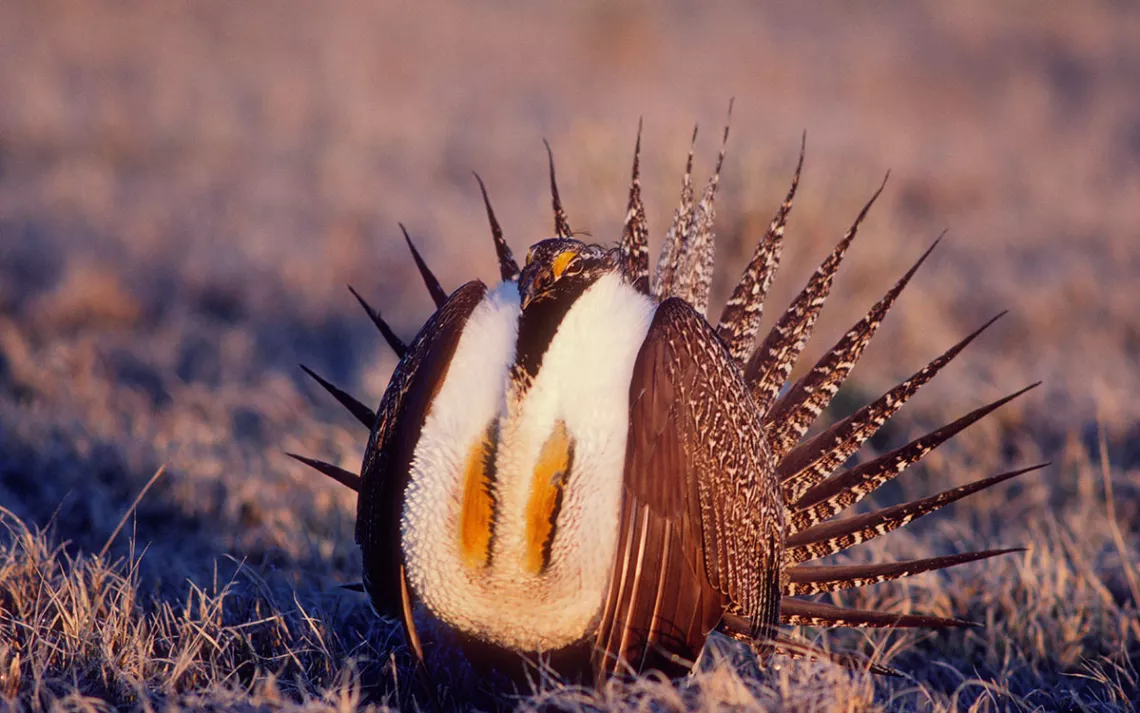The Biden Administration Throws a Lifeline to the Greater Sage-Grouse
Public asked to weigh in on new rule to limit development on the bird's habitat across much of the West

A male sage-grouse on a lek in Montana. | Photo by KeithSzafranski/iStock
One of the most iconic species in the West is a bird with a flashy mating dance. Every spring, greater sage-grouse gather at sites called leks to compete for mates. The males puff out their chests—literally expanding bright-yellow sacs in their chests like balloons—and spread their spiky tail feathers, like a splayed folded fan, to attract females.
However, the birds have faced a significant population decline in the last few decades. They make their homes in large swaths of the sagebrush steppe, a unique grassland system that is threatened by human development, livestock grazing, drought, and invasive cheatgrass. The “sagebrush sea,” spanning much of the Intermountain West, is the largest terrestrial ecosystem in the lower 48 states—but a 2022 US Geological Survey report found that over the last 20 years, an average of 1.3 million acres of sagebrush have been lost or degraded annually. Greater sage-grouse populations are suffering because of this: From 1965 to 2021, their numbers plummeted by nearly 80 percent. According to the Bureau of Land Management (BLM), populations once in the millions now number fewer than 800,000.
Of the remaining 145 million acres of viable habitat, approximately 67 million acres are managed by the BLM. In March, the federal land management agency announced the release of the Greater Sage-Grouse Resource Management Plan. The plan, currently in draft form, could limit uses like energy development and livestock grazing across 10 western states—giving the birds the protections they sorely need.
It outlines six alternatives that each balance conservation and development in different ways. The BLM’s preferred alternative details conservation efforts on newly defined “habitat management areas” that encompass essential zones for the birds. Those areas were also chosen based on climate change models, according to the BLM’s national sage-grouse conservation coordinator, Pat Deibert: “We wanted to be realistic in that we’re managing sagebrush habitats that will still be sagebrush in 30, 40, 50 years from now—versus areas that, quite frankly, have tripped an ecological threshold,” she said.
In addition to limiting oil and gas drilling, the plans could also slow renewable energy development—though those limits are more flexible than for oil and gas. Still, any restrictions are likely to help the greater sage-grouse. Recent science has shown that the birds are very sensitive to disturbance: In 2023, the USGS found that populations within three miles of two new geothermal energy plants in Nevada declined substantially in the years after the plants were built. Cameron Aldridge, an ecologist with the US Geological Survey whose research focuses on the greater sage-grouse, said the birds require sagebrush at every stage of their life cycles—they use the plant to hide from predators, to nest beneath, as mating grounds, and they eat it too, especially in the winter. For populations to thrive, they need the sagebrush across vast and unimpeded landscapes.
Because of this, some wildlife conservation groups say the proposed restrictions don’t go far enough. “The draft proposal still allows for oil and gas drilling, mining, and other activities—some of the biggest threats to the bird’s habitat,” said Vera Smith, senior federal lands policy analyst with Defenders of Wildlife, in a statement. “We need a drastic departure from the BLM’s approach of whittling away at the last best places for the sage-grouse.”
Protections for the bird have seesawed since 2014. That year, Republicans in Congress blocked the US Fish and Wildlife Service from listing the greater sage-grouse under the Endangered Species Act, which would have included overarching protections for their habitats. In response, the Obama administration in 2015 limited developments on 10 million acres. The Trump administration challenged that action in 2018, but subsequent court intervention meant that neither administrations’ management plans were ever fully implemented.
Now, the BLM has a decade’s worth of new science to rely on for its new plan, which builds on previous guidelines. This framework acts as an umbrella: It’ll help redefine goals and conservation priorities in 77 existing state and local resource management plans that currently encompass greater sage-grouse habitats. Essentially, this new plan will determine how local swaths of public lands will be required to interact with those areas. The BLM says the plan could also protect hundreds of other western species—including mule deer, pronghorn, and the pygmy rabbit—that live in the sagebrush sea.
During an initial scoping period, the BLM received nearly 1,900 comments and held over 100 meetings with local, state, federal, and tribal partners. Many initial comments supported the BLM’s proposal to create this plan. In a statement, BLM director Tracey Stone-Manning called the efforts to conserve the greater sage-grouse and its habitat “the largest collaborative conservation effort in our history.”
You can be a part of that effort: Public comments on the plan are open through mid-June. According to Audubon, a plan to truly save the greater sage-grouse will balance energy development with the need for “healthy, unfragmented habitat” and implement science-based management plans—things the organization is asking people to mention in their comments. “Everyone’s got to pay attention,” Alison Holloran, executive director of Audubon Rockies, told the Wildlife Society. “Everyone has a role to play.”
 The Magazine of The Sierra Club
The Magazine of The Sierra Club
